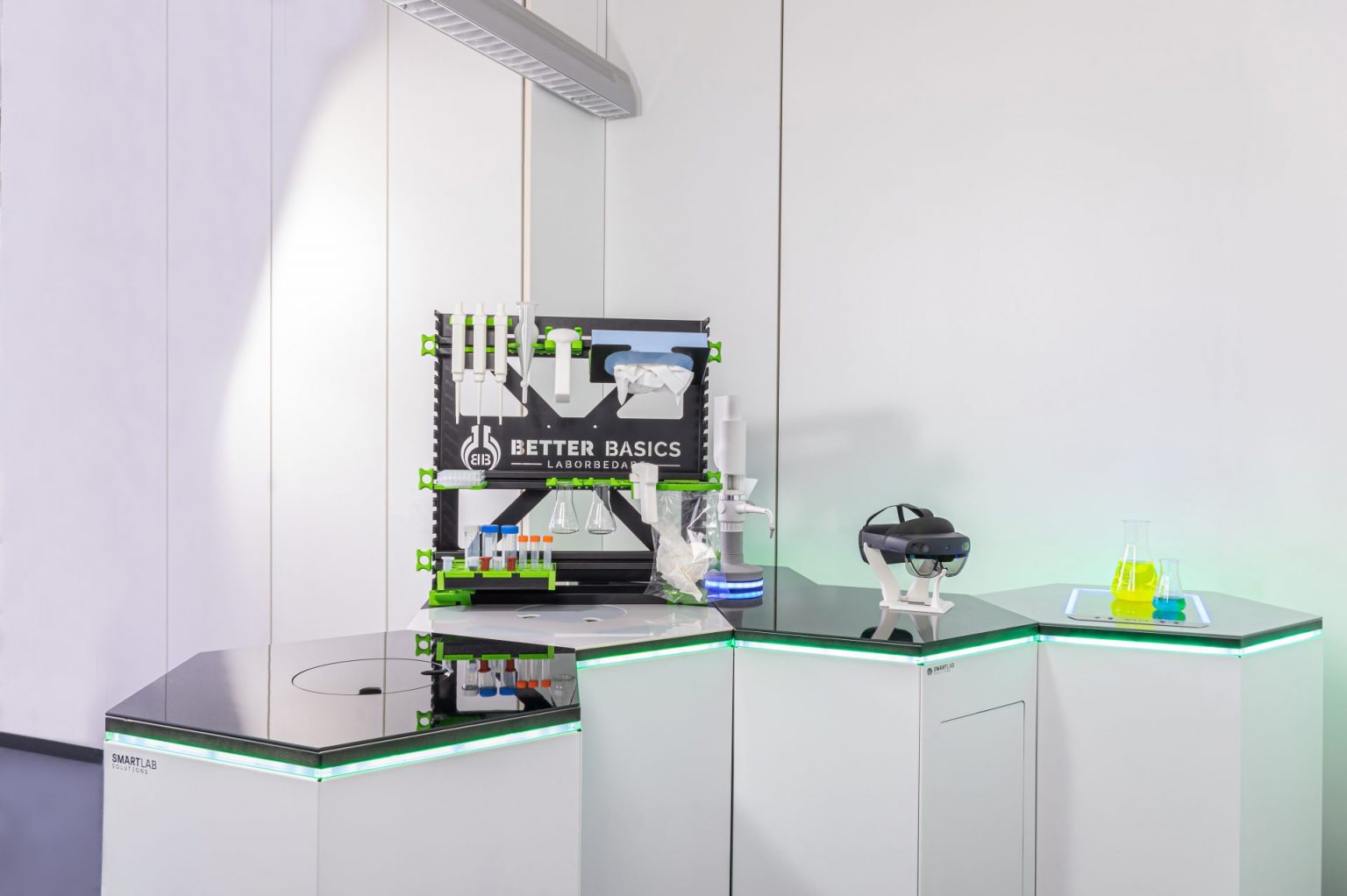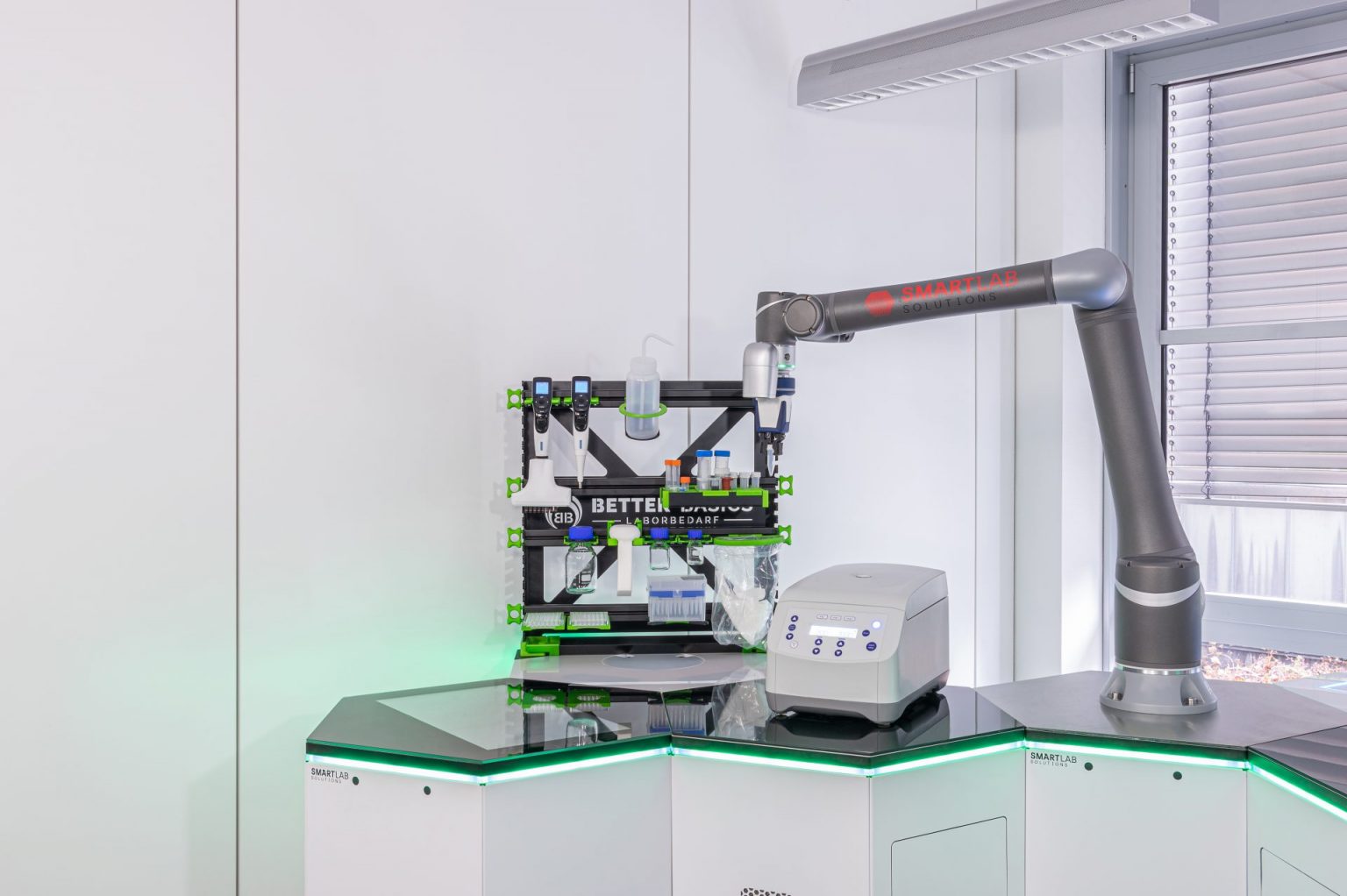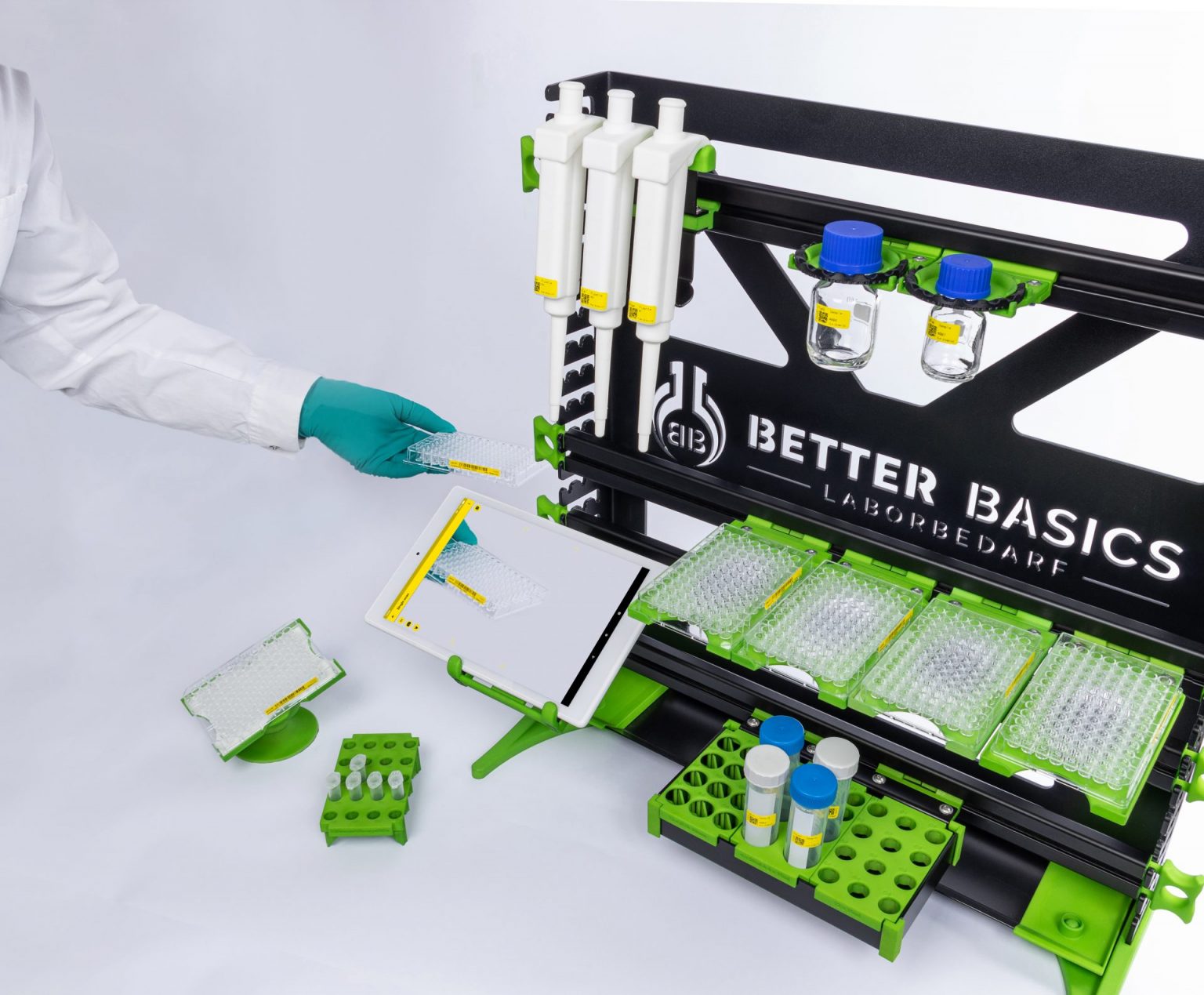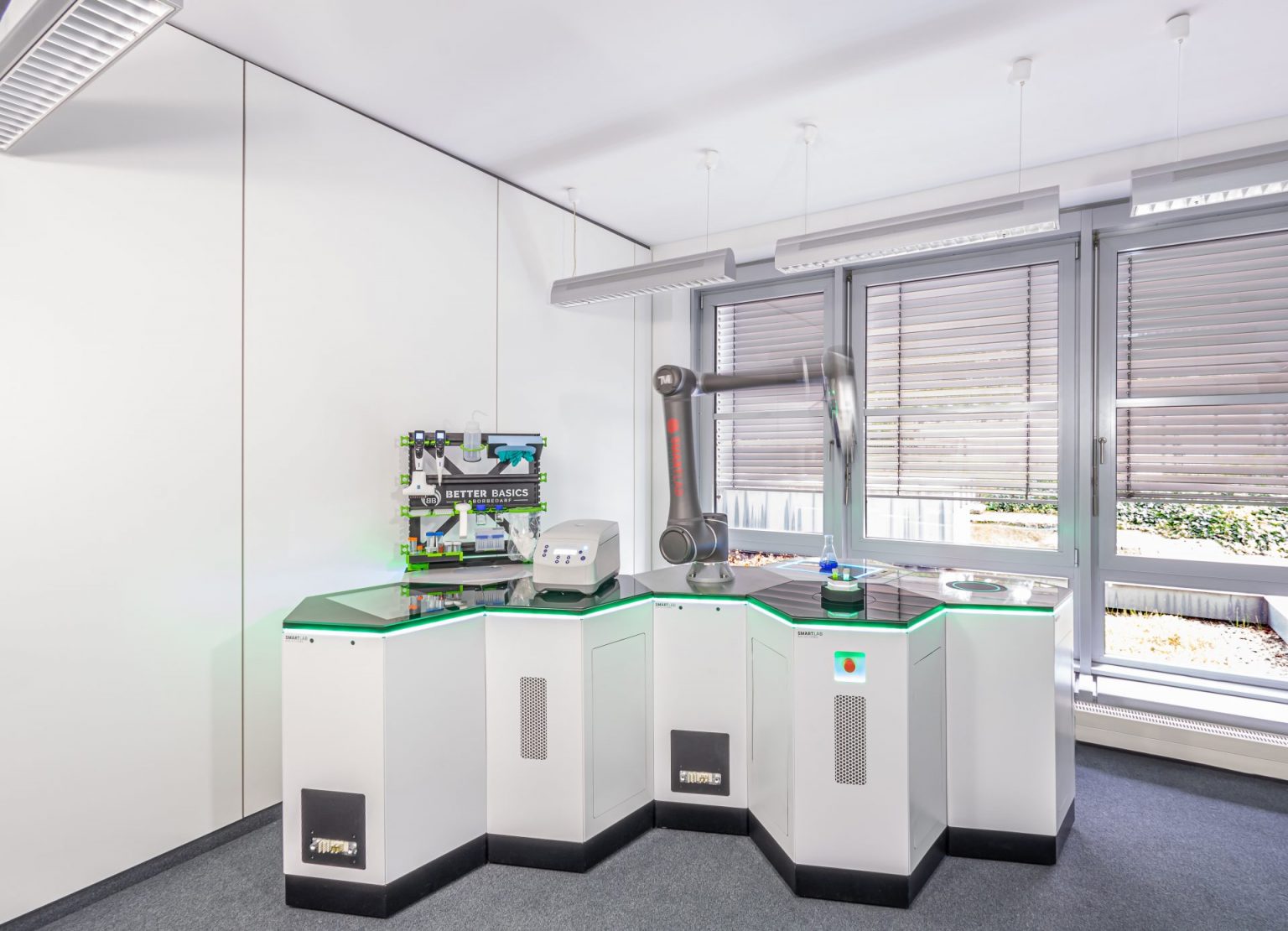Digitisation, automation and shared economy
Solutions for the challenges of the future
Occupational safety in the laboratory has always been a topic of enormous importance, but topics such as the sharing of laboratory resources, digitisation in the laboratory and laboratory automation are also becoming increasingly important. Likewise, a completely new field of location-independent working is now also emerging in the field of the laboratory industry. In chemistry laboratories as well as in biology laboratories, both cost pressure and the need for a more efficient use of existing workplace structures are growing. Previously, a laboratory workstation was permanently intended for a laboratory assistant and was used permanently for years, but today it has demand-oriented uses which have to adapt to constantly changing tasks. Some universities and research institutes are already pioneers and offer their resources internally for booking across working groups. However, the most common reason for a shared economy in the field of laboratory technology is currently the savings potential with high investment costs, which can be significantly reduced by better use.
However, the age-appropriate design of workplaces is becoming just as important as it is relevant in the wake of the increasing shortage of skilled workers. Providing the technically optimal laboratory workstation for the respective activity with the best working conditions as a company will be a logistical challenge, especially if sustainability criteria are to be taken into account. Laboratory companies will be faced with the challenge of balancing the personal performance and the individual skillset of their employees as well as operational working conditions in all age groups and still remaining successful in business. This is a new, if indirect, reason to make laboratory workstations flexible and modular.

Solutions for all these questions are practically already available, but not in the combination which would be necessary to answer this question. The key to success seems to lie in the use of modularised individual resources, which should be available to several users in a short time by booking and providing as well as returning laboratory equipment. Companies like the Life Science Factory in Göttingen are already offering laboratory workstations as coworking areas, and users have access to the best working conditions at optimised costs without their own laboratory infrastructure. It may justifiably be considered whether in the future, in addition to the classic office environment, much more infrastructure might not be used more efficiently by sharing. This would result in the option, in addition to normal office space, of better using laboratory capacities with cost-intensive equipment through shared use. Models for the short-term conversion from office to laboratory areas and back are also already being planned and prepared. This reduces investment costs and also strengthens sustainability in all areas. At the same time, a rethinking on the part of the users must take place, since the previous way of using the laboratory would receive an update. In the following text, existing solutions will be presented by way of example and their potentials and possible synergies will be considered.
Sharing Economy - from the library to the laboratory
We don’t have to reinvent the wheel, because there is already a blueprint for this innovative working model of a shared economy. It is available in every major city and is known as one of the oldest sharing models in the world: The Library. So let’s take a look at how book loans have been working very successfully for many decades. Depending on their needs, users search out their books according to their interests and have them ready at a pick-up station. Depending on availability, they can be removed to a collection shelf at a specific time. The loan is confirmed by ID card or app or online. After the time has elapsed, the books are not individually returned to the original shelf by the user; instead, the return takes place with the same ID card or registration option at a return station. Here, the number and condition of the printed copies are checked, and the publications are then sorted back to their original place by librarians. The system is known and familiar to every researcher as well as academics – it is not known why it has not yet found its way directly into the use of laboratory workstations. It may be due to the somewhat different conditions which apply in chemistry or biology laboratories, because working under safety fume hoods and handling chemicals or biological samples naturally places their own requirements on the return of the equipment used and its cleaning. Nevertheless, these points can be solved and optimised surprisingly easily.
So let’s visualise the challenge to be solved. The “classic” laboratory workstation consists of
- a safety fume hood, a safety workbench or a laboratory table
- holders for laboratory glassware or vessel holders for e.g. microreaction vessels
- Laboratory equipment, such as scales, rotary evaporators, magnetic stirrers, microlitre centrifuges
- consumables, as well as
- the components of the actual samples.
The classic laboratory environment, whether as part of a company, a university or – quite innovatively – as part of an offer of a coworking space – is of course needed as a basis. Other components of mobile working in the laboratory can be adapted.

There is no need to reinvent the wheel, a blueprint for the seemingly innovative work model of a shared economy already exists. It is available in every major city and is known as one of the oldest sharing models in the world: The library.
Dr. Marcus Heinze, Development Manager
Booking
Ideally, a laboratory assistant will book a laboratory fume hood for a defined time window for a task. Depending on the content of the work and the personal requirements, this workplace would be reserved online or via an app. As part of the booking, the task to be implemented in principle is also recorded, which must be solved on the corresponding working day. At the time of booking, the sample composition would also have to be named. For example, when booking a laboratory workstation, the DESY “Deutsches Elektronen-Synchrotron DESY, a research center of the Helmholtz Association” asks its users to provide the following information: the date and time frame in which the laboratory environment will be used, the exact chemical composition of the samples, as well as the nature and scope of the tasks to be performed. Part of the data collection is the necessary configuration of the required equipment, which is provided for collection in the form of laboratory equipment, consumables as well as glass devices and sample vessels. A system is already available on the market for this part of the task as well. The company Clustermarket offers a booking system for scientific institutions, with which laboratories of various kinds can make their resources and capacities available to users. Likewise, a reservation can be canceled or rebooked, which would transfer the task configuration to the date of the new booking. An interactive map would help with navigation and better orientation in the laboratory. This would also ensure that resources located on site are used optimally and that search and distribution times are reduced. The creation of booking profiles for each user would also significantly simplify the configuration of the laboratory workstation. The design or layout of a workplace, its necessary components, etc. would be stored in the software and so would be available for future projects. Ideally, also at different laboratory locations.

One of the key reasons for operational inefficiency is that data is often held in silos. Paper notebooks, disk-based documentation, and standalone server-based systems are still common in R&D labs. Therefore, digital tools, such as an equipment scheduling system, are essential for efficient operation of the laboratory. However, having multiple systems also creates additional workload for lab managers. Often, data created in digital tools is siloed and needs to be manually inserted into other tools used in the workflow. This leads to slow adoption of digital solutions in R&D labs and a disappointing experience for researchers. To avoid these issues and ensure a smooth lab workflow, all tools implemented in an R&D lab should be easily connected to other tools in use. This ensures a quick and smooth introduction to the tool and the best experience for the user. A digital tool like a lab instrument booking system, which everyone can easily access from their laptop or lab computer, helps to have a clear picture of who has reserved a particular instrument and when. This makes it easier to coordinate schedules, avoid overlapping bookings and check equipment availability. Additionally, a single system where anyone can access and book all relevant laboratory resources helps improve instrument utilization and helps make more informed purchasing decisions. The ability to message lab members to notify them of changes in lab schedules or to announce instrument maintenance is handy and lessens the admin work. Most importantly, if the data from the ELN or inventory system used by the laboratory can be connected to the scheduling software, it can make the workflows smoother and the management of the laboratory easier.

The SmartRack® as a laboratory organization system acts as an assistance system so that every laboratory employee, once familiar with how the organization system works, can transform any laboratory workstation into a familiar working environment for themselves. This is easy to achieve with Better Basics Laborbedarf's solution, the SmartRack® as a laboratory organization system; every workstation can thus be set up with laboratory glassware, pipettes, consumables and other utensils in a practical and space-saving way, modularly and adaptable at any time, thanks to the diverse SmartRack® modules.
Dr. Marcus Heinze, Development Manager
The organisation of the laboratory workplace for efficient and safe work
Working without a spatially fixed workstation requires a system which supports laboratory employees in setting up their laboratory workstation as quickly as possible and preparing it for its task – and always at a different place in the laboratory. In contrast to this would be the problem of the large amount of time spent on the daily preparation. To avoid this, an organisational system is needed which can be quickly and flexibly adapted to the individual needs of the user and is available at every workplace. This laboratory organisation system acts as an assistance system, so that every laboratory employee who has been familiarised with the functioning of the organisational system once can transform each laboratory workstation into a familiar working environment for themselves. With the solution from Better Basics Laborbedarf, the SmartRack® as a laboratory organisation system, this is easy to achieve; so each workplace can be set up with the diverse SmartRack® modules with laboratory glassware, pipettes, consumables and other utensils in a practical and space-saving way which is easy, modular and can be adapted at any time. Alternatively, individual solutions according to specific customer requirements can also be obtained via Better Basics Laborbedarf. The SmartRack® can be understood as a modular laboratory organisation system, which consists of a stable metal frame, groove rails and modules which can be hung modularly in it. The laboratory employee can mount their glass devices, samples, laboratory accessories or consumables in these modules. In this way, every user can personalise his SmartRack® in the shortest possible time and adapt it to his individual needs and, by doing so, organise his work safely and in a structured way. The SmartRack® and all its components are autoclavable and can be cleaned with mild soapy water, making it suitable for use in chemistry, biology, biochemistry, the food industry, pharmacy as well as medicine. With a possible space saving of up to 80% at the laboratory workstation, it offers many possibilities to create free workspace and thus enable efficient work.

Since SmartRack® users have access to a large range of over 100 modules for storing laboratory equipment, its use in any laboratory is possible and makes technical as well as economic sense. With the SmartRack® in practice, a gap to other branches of industry is also closed, because as the world’s first laboratory organisation system, SmartRack® allows the use of the 4D or 8D method for the automotive industry. Since every error should be solved causally after its first occurrence, at this point the SmartRack® offers the potential to virtually eliminate any error by safely storing laboratory glassware and laboratory accessories. Order and the avoidance of sample losses and confusion are a significant advantage of the SmartRack®. The use of the three ergonomics areas of the laboratory workstation, the gripping area, the reaching area and the stretching area are optimally used, since the SmartRack® makes optimum use of the height or the air space in the laboratory fume hood, above the laboratory table or the safety workbench and thus offers space for optimal work in the gripping area. It is this order and this clear structure in the personal work environment which, for example in the automotive industry, helps to avoid accidents at work and in this way significantly increases occupational safety. A clear division of the workplace as well as the similar placement of laboratory accessories help to avoid lapses of concentration and therefore prevent errors. As a result, in this way the SmartRack® aids ergonomics at the laboratory workplace and relieves laboratory employees, which contributes to higher satisfaction and motivation at the workplace.
The material
Consumables, laboratory equipment and laboratory accessories are an essential aspect of daily laboratory work. Since research is not an exact process to be booked, the adequate availability of the material must be guaranteed. Whether when taking over the booked laboratory workstation or when receiving the laboratory organisation system and laboratory equipment, individual coordination must be carried out. If additional consumables are required, they should also be available semi-centrally in the immediate vicinity of the actual laboratory workstation in order to be able to access them quickly and efficiently during the working day. Ideally, these consumables are calculated on a flat-rate basis. Another step to be discussed is the removal and return of the work equipment as well as the handling of samples and laboratory waste. At the end of the laboratory working day, the proper disposal of the consumables and the return of the laboratory organisation system, including the previously handed over modules, unused consumables and laboratory equipment, will be completed. These would be sorted after the previous use, cleaned and stored again.

In the future, the laboratory of the future will be configurable for planned projects and can be converted and equipped according to the project. This means that work can be planned much more efficiently. Inventories could also be carried out much more quickly using a booking system, since the requirements, setup and layout of the laboratory could be matched directly with data from a laboratory booking system.
Dr. Marcus Heinze, Development Manager
Temporal and spatial flexibility
A mobile mode of operation would also be practically feasible in the case of a longer test procedure. The company Better Basics Laborbedarf offers a specially designed SmartCase for the SmartRack® in which the SmartRack® including samples can be turned off and closed. The SmartCase has an automatic valve system via which the atmosphere inside the SmartCase can be exchanged by external gas supply. So several side-by-side SmartCase with test setups located in them are also storable for several days – encoded with an E-ink label, the corresponding SmartCase would later be reassignable to a laboratory assistant, in addition to the information on the contents contained therein.
Digitisation in the laboratory
In addition to the economic and spatial reasons for sharing laboratory resources, it is the handling of large amounts of data which will influence laboratory work. Inconsistent processes and non-standard workflows mean that data is still entered manually. For the most part, it is still recorded in paper form and only typed up by hand later. The associated risk of error is enormous. The data formats in which this information is recorded are also limited to Excel or comparable programs. The associated decentralised data storage leads to a low integration of the data into context-related analysis programs. One solution is the “digital” laboratory, in which workflows are specified through screens. This ensures a uniform test or analysis procedure. At the same time, all data are recorded and backed up in a structured manner. Later, an evaluation can be carried out in almost any way. Solutions such as the Clustermarket booking software are optimally integrated here, as they are also able to carry out monitoring and controlling. The fact that devices for analysis and measurement as well as sensors are directly networked with each other seems to be more than sensible in this context. At the same time, they also deliver their data directly to the uniform laboratory management system and complement each other with the data entries of the laboratory technicians

Laboratory safety
Safety is a top priority, because laboratory accidents are expensive and fraught with consequences. In 2018 alone, 15,000 laboratory accidents were reported in Germany, which cost an average of 25,000 euros. Of course, frequently changing workplaces also mean constant new challenges in terms of use and knowledge of the environment and the technology used. Proper instruction and occupational health and safety instruction is necessary and unavoidable for occupational health and safety reasons. Otherwise, a scenario would quickly emerge from the possible advantages of a flexible laboratory working method, in which the consequences of an accident would turn every benefit into a negative.
Laboratory automation
So far, classic holders such as the traditional 3-finger clamp have dominated the laboratory workstation in safety fume hoods, which means that the experimental arrangement remains very traditional. Automation in the laboratory is a major issue when recurring processes can and should be implemented in a constant environment. This is exactly where conventional laboratory equipment has its weak points. After all, all automated processes depend on the certainty that all process steps can be repeated and implemented exactly according to the same criteria. The way out is currently offered by laboratory arrangements in which robots can work safely in specially equipped laboratories. The hybrid use of humans and robot systems places special demands which a modern laboratory organisation system such as the SmartRack® can fulfil.
Synergies
Even the presentation of the various influencing criteria gives an idea of the great potential which has to be tapped by a holistic use of laboratory structures. Depending on the field of application, these optimisation potentials are distributed differently. Some of the possibilities are presented here in thought. For example, the topic of occupational safety could be significantly improved by standardisation. Via the booking system, such as the solution offered by Clustermarket, an instruction on all security-relevant topics can already be given online. By using a uniform laboratory organisation system, such as the SmartRack®, with standardised holders for laboratory glassware, which can be used at any laboratory workstation, the effort for instructions and thus the resulting error potential is also reduced, because users are increasingly familiar with the ordering system, since this is available at all workstations. If the same modules and module systems are used for several years, errors resulting from ignorance and improper use are also reduced.

A booking system which can measure the use of consumables and laboratory capacities (cf. www.clustermarket.com), helps, among other things, to optimise the purchase of these consumer goods. Larger quotas of excipients can be purchased, and at better conditions – an opportunity for optimisation which has not been practically used so far. The intermediate storage of samples until analysis in a system solution such as the SmartCase also saves costs directly, because the laboratory fume hood used on the day of sample preparation is now free for the duration of interim storage and can be used for other purposes. The SmartRack® offers the best conditions for this. Another advantage of the SmartRack® reveals itself in its use in partially or fully automated laboratories. Due to the defined positioning of all its modules, the basis to enable the use of robots was created on the SmartRack®. In order to prepare a laboratory well for the future and for the possibilities of automated laboratory work, the equipment with an order system such as the SmartRack® would be the perfect preparation. So the classic, manual as well as partially or semi-automated laboratory work would be combined and mutually supplemented. Both laboratory technicians and robots would be able to use the same basic laboratory equipment. A reconstruction of the laboratory would not be necessary. The tablet holder optionally integrated onto the SmartRack®, for example, creates an additional interface between man and machine and simplifies the hybrid use of the laboratory by man and machine.
Due to bookings and thus known requirements for space and equipment, even entire laboratories can be flexibly designed with regard to their layout and composition in a period of one to fifteen days. A laboratory can therefore be configured for planned projects in the future and can be converted and equipped on a project-by-project basis. This makes work much more efficient to plan. Inventories would also be much faster to carry out through a booking system, since the requirements, setup and layout of the laboratory would have to be compared directly with data from a laboratory booking system.
Conclusion: the design of laboratories which will be planned and set up in the coming years will change significantly
The focus is on increasing efficiency and flexibility, as well as focusing on future aspects such as automation and the prevention of accidents and errors. If the first laboratories are set up to this new, very high standard by corporations and the resulting potential becomes clear, the operators of conventional laboratories are faced with a big question: how should they compensate for the deficit in profitability and efficiency? Thanks to the described modularity of the new solutions, a retrofit as well as a conversion is practically possible at any time. It is important to be one step ahead of the inevitable changes in all areas of today’s life. As always, this starts with the willingness to recognise change as an opportunity.
Further Information
You can download our product catalog as a PDF file from the downloads section of our website.
If you are interested in our products, please use the inquiry form in the downloads section.
